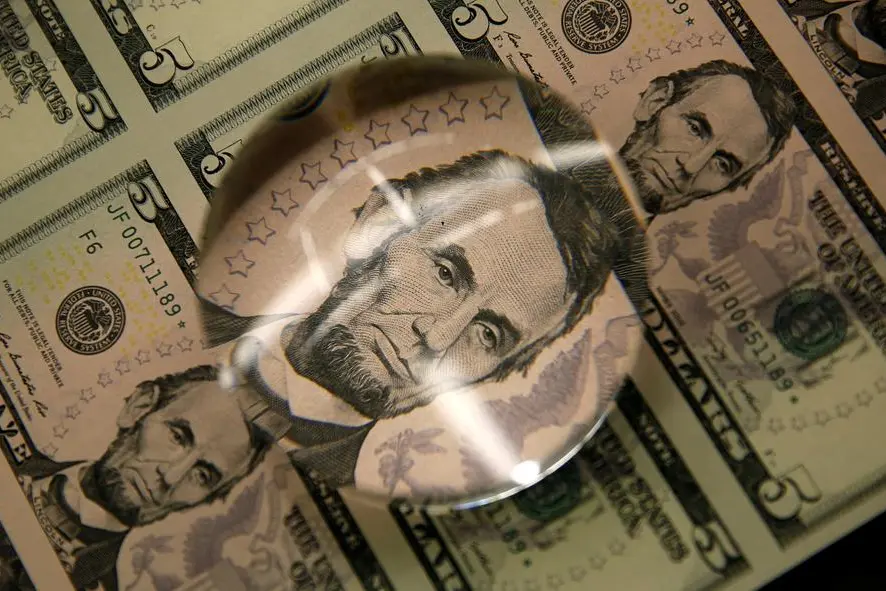PHOTO
The dollar advanced on Wednesday, recovering from two-month lows hit the previous session, as investors lightened their short positions to book profits ahead of the all-important U.S. non-farm payrolls report on Friday.
The underlying trend though for the dollar remained tilted to the downside and Wednesday's U.S. private sector jobs numbers affirmed that.
The jobs data supported the view that the Federal Reserve may not need to raise rates much further.
Investors are looking to Friday's non-farm payrolls report for March, with economists polled by Reuters expecting new jobs of about 240,000.
In afternoon trading, the dollar index rose 0.4% to 101.87, led by gains against the euro, which fell 0.5% to $1.0906. Erik F. Nelson, macro strategist at Wells Fargo in London, said for now, "the bar for the dollar to keep falling is high," noting that the greenback tracks U.S. Treasury yields, which have seen extreme moves in recent weeks.
In March, U.S. two-year yields, which reflect interest rate expectations, sank nearly 74 basis points (bps), the worst monthly fall since January 2008, which was in the thick of the global financial crisis.
"We need to see continued weakness in the data because part of the dollar weakness we're seeing is coming from falling U.S. rates and cuts being priced from the Fed. And if the U.S. data is not going to affirm that, then the dollar could be more resilient than expected," Nelson said.
He clarified though that he remains dollar-bearish, but noted that moves in the currency will be more of a "grind lower," instead of a straight downtrend that reflect months and months of persistent selling.
On Wednesday, the ADP National Employment report showed U.S. private employers hired fewer workers than expected in March, suggesting a cooling labor market.
Private employment increased by 145,000 jobs last month, while economists polled by Reuters had forecast private employment increasing by 200,000.
The data came after Tuesday's report showing a decline in job openings for February and on the heels of Monday's weak U.S. manufacturing survey from the Institute for Supply Management, which also pointed to a soft employment component.
Another report on Wednesday also indicated continued economic weakness, this time in the services sector.
That industry slowed more than expected in March as demand cooled, while a measure of prices paid by services businesses fell to the lowest in nearly three years.
The ISM's non-manufacturing index fell to 51.2 last month from 55.1 in February, while the prices paid component declined to 59.5 from 65.6 in February, with the services sector's employment indicator sliding as well to 45.8 from 47.6 in February.
"There is plenty of evidence in the pipeline showing that disinflation is the underlying trend...and part of the basis as to why the Fed is sounding ambiguous these days," said Thierry Wizman, global FX and rates strategist at Macquarie in New York.
Cleveland Fed President Loretta Mester, a known hawk, said in an interview with Bloomberg TV on Wednesday that it was too early to know if the Fed would need to raise its benchmark rate at its next policy meeting in early May.
U.S. rate futures markets are now pricing in a 55% chance of the Fed leaving rates unchanged at its next meeting, up from a 43% chance a day earlier. Market have also priced in about 85 bps cuts by the end of the year.
In other currencies, the dollar posted its third daily loss against the yen, falling 0.4% to 131.15. Against the Swiss franc, the greenback was little changed at 0.9060 francs
The Australian dollar dropped 0.5% against the U.S. currency to US$0.6720, a day after its central bank left rates unchanged at 3.6% following 10 straight hikes, saying it needed more time to assess the impact of past increases.
The New Zealand dollar, meanwhile, rose 0.1% versus the greenback to US$0.6316, rallying by as much as 1.1% to a two-month high of US$0.6379 after the Reserve Bank of New Zealand unexpectedly raised interest rates by 50 bps to a more than 14-year high of 5.25%.
(Reporting by Gertrude Chavez-Dreyfuss; Additional reporting by Amanda Cooper in London and Ankur Banerjee in Singapore; Editing by Sonali Paul, Muralikumar Anantharaman, Chizu Nomiyama and Conor Humphries)





















